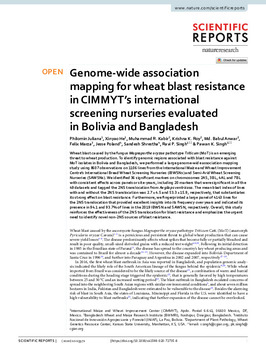Mostrar el registro sencillo del ítem
Genome-wide association mapping for wheat blast resistance in CIMMYT’s international screening nurseries evaluated in Bolivia and Bangladesh
| Creador: | Juliana, P. |
| Creador: | Xinyao He |
| Creador: | Kabir, M.R. |
| Creador: | Roy, K.K. |
| Creador: | Anwar, M.W. |
| Creador: | Marza, F. |
| Creador: | Poland, J.A. |
| Creador: | Shrestha, S. |
| Creador: | Singh, R.P. |
| Creador: | Singh, P.K. |
| Año: | 2020 |
| URI: | https://hdl.handle.net/10883/20980 |
| Formato: | |
| Lenguaje: | English |
| Editor: | Nature Publishing Group |
| Copyright: | CIMMYT manages Intellectual Assets as International Public Goods. The user is free to download, print, store and share this work. In case you want to translate or create any other derivative work and share or distribute such translation/derivative work, please contact CIMMYT-Knowledge-Center@cgiar.org indicating the work you want to use and the kind of use you intend; CIMMYT will contact you with the suitable license for that purpose |
| Tipo: | Article |
| País de enfoque: | Bolivia |
| País de enfoque: | Bangladesh |
| Lugar de publicación: | London (United Kingdom) |
| Número: | 1 |
| Volumen: | 10 |
| DOI: | 10.1038/s41598-020-72735-8 |
| Descripción: | Wheat blast caused by the fungus Magnaporthe oryzae pathotype Triticum (MoT) is an emerging threat to wheat production. To identify genomic regions associated with blast resistance against MoT isolates in Bolivia and Bangladesh, we performed a large genome-wide association mapping study using 8607 observations on 1106 lines from the International Maize and Wheat Improvement Centre?s International Bread Wheat Screening Nurseries (IBWSNs) and Semi-Arid Wheat Screening Nurseries (SAWSNs). We identified 36 significant markers on chromosomes 2AS, 3BL, 4AL and 7BL with consistent effects across panels or site-years, including 20 markers that were significant in all the 49 datasets and tagged the 2NS translocation from Aegilops ventricosa. The mean blast index of lines with and without the 2NS translocation was 2.7 ± 4.5 and 53.3 ± 15.9, respectively, that substantiates its strong effect on blast resistance. Furthermore, we fingerprinted a large panel of 4143 lines for the 2NS translocation that provided excellent insights into its frequency over years and indicated its presence in 94.1 and 93.7% of lines in the 2019 IBWSN and SAWSN, respectively. Overall, this study reinforces the effectiveness of the 2NS translocation for blast resistance and emphasizes the urgent need to identify novel non-2NS sources of blast resistance. |
| Agrovoc: | PLANT GENETICS |
| Agrovoc: | GENETIC MARKERS |
| Agrovoc: | PLANT BREEDING |
| Agrovoc: | WHEAT |
| Agrovoc: | DISEASE RESISTANCE |
| Datasets relacionados: | https://www.nature.com/articles/s41598-020-72735-8#Sec22 |
| ISSN: | 2045-2322 |
| Revista: | Scientific Reports |
Ficheros en el ítem
Este ítem aparece en la(s) siguiente(s) colección(ones)
-
Wheat
Wheat - breeding, phytopathology, physiology, quality, biotech

